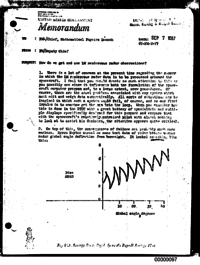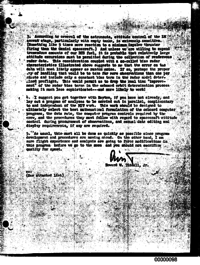FM4/Chief, Mathematical Physics BranchSEP 7 196767-FM-T-77FM/Deputy ChiefHow do we get and use LM rendezvous radar observations?
1. There is a lot of concern at the present time regarding the manner in which the LM rendezvous radar data is to be processed onboard the spacecraft. I feel that you should devote as much attention to this as you possibly can since it influences both the formulation of the space- craft computer program and, to a large extent, crew procedures. Of course, there are the usual problems associated with any system which must edit and weigh data automatically. All sorts of situations may be imagined in which such a system would fail, of source, and so our first impulse is to somehow get the men into the loop. When you consider how this is done in the RTCC with a great battery of specialists and multi- ple displays specifically designed for this purpose and compare that with the spacecraft's relatively untrained pilot with almost nothing to look at to assist his decision, the situation appears quite critical.
2. On top of this, the consequences of failure are probably much more serious. Myron Kayton showed me some test data of radar biases verses radar gimbal angle deflection from boresight. It looked something like this:
[illustration omitted]
3. According to several of the astronauts, attitude control of the LM ascent stage, particularly with empty tanks, is extremely sensitive. (Something like 5 times more reaction to a minimum impulse thruster firing than the Gemini spacecraft.) And unless we are willing to expend tremendous amounts of our RCS fuel, it is probable that relatively large attitude excursions must be permitted during the collection of rendezvous radar data. This consideration coupled with a so-called bias radar characteristics illustrated above suggests to me that the error on the data will most likely appear as random noise. If so, perhaps the proper way of handling that would be to take far more observations than one per minute and include only a constant bias term in the radar model deter- mined preflight. This would permit us to drop the real time “improve- ment” of the radar bias terms in the onboard orbit determination process making it much less sophisticated—and more likely to work!
4. I suggest you get together with Kayton, if you have not already, and lay out a program of analyses to be carried out in parallel, complimentary to and independent of the MIT work. This work should be designed to ultimately select the best mathematical formulation of the onboard computer programs, the data rate, the computer program controls required by the crew, and the procedures they must follow with regard to spacecraft attitude control during procurement of observations, and manual data editing and display requirements, if any are required.
5. As usual, this must all be done as quickly as possible since program development and procedures are moving ahead. On the other hand, I am sure flight experience and analysis are going to force modifications in this program before we go to the moon and you should not sacrifice quality for speed.
- Dec 07, 1967 – Light weight LM attitude control is too sporty. (4.7σ)
- Jan 20, 1967 – Why is it everyone who loves radar wears a white hat? (3.6σ)
- Aug 28, 1967 – Analysis of LM rendezvous navigation is needed (3.7σ)


